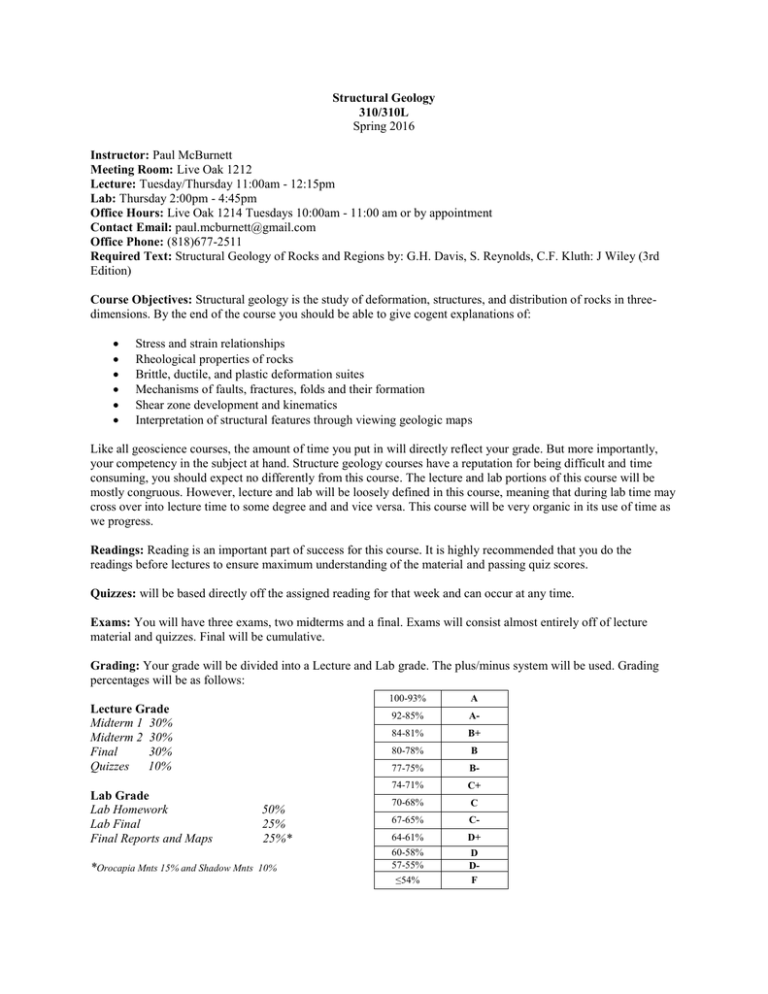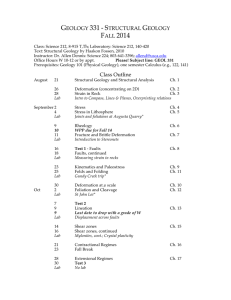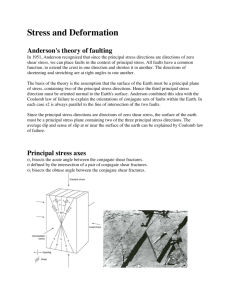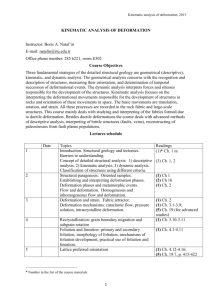Structural Geology Syllabus - Course Outline & Grading
advertisement

Structural Geology 310/310L Spring 2016 Instructor: Paul McBurnett Meeting Room: Live Oak 1212 Lecture: Tuesday/Thursday 11:00am - 12:15pm Lab: Thursday 2:00pm - 4:45pm Office Hours: Live Oak 1214 Tuesdays 10:00am - 11:00 am or by appointment Contact Email: paul.mcburnett@gmail.com Office Phone: (818)677-2511 Required Text: Structural Geology of Rocks and Regions by: G.H. Davis, S. Reynolds, C.F. Kluth: J Wiley (3rd Edition) Course Objectives: Structural geology is the study of deformation, structures, and distribution of rocks in threedimensions. By the end of the course you should be able to give cogent explanations of: Stress and strain relationships Rheological properties of rocks Brittle, ductile, and plastic deformation suites Mechanisms of faults, fractures, folds and their formation Shear zone development and kinematics Interpretation of structural features through viewing geologic maps Like all geoscience courses, the amount of time you put in will directly reflect your grade. But more importantly, your competency in the subject at hand. Structure geology courses have a reputation for being difficult and time consuming, you should expect no differently from this course. The lecture and lab portions of this course will be mostly congruous. However, lecture and lab will be loosely defined in this course, meaning that during lab time may cross over into lecture time to some degree and and vice versa. This course will be very organic in its use of time as we progress. Readings: Reading is an important part of success for this course. It is highly recommended that you do the readings before lectures to ensure maximum understanding of the material and passing quiz scores. Quizzes: will be based directly off the assigned reading for that week and can occur at any time. Exams: You will have three exams, two midterms and a final. Exams will consist almost entirely off of lecture material and quizzes. Final will be cumulative. Grading: Your grade will be divided into a Lecture and Lab grade. The plus/minus system will be used. Grading percentages will be as follows: 100-93% Lecture Grade Midterm 1 30% Midterm 2 30% Final 30% Quizzes 10% Lab Grade Lab Homework Lab Final Final Reports and Maps 50% 25% 25%* *Orocapia Mnts 15% and Shadow Mnts 10% A 92-85% A- 84-81% B+ 80-78% B 77-75% B- 74-71% C+ 70-68% C 67-65% C- 64-61% D+ 60-58% 57-55% ≤54% D DF Tentative Class Schedule Week Beginning Tuesday Thursday January 25th Chapter 1: Nature of Structural Geology (2-33); Map interpretation tools; strike lines, Rule of V's, Classification; terminology, symbols; Cross Sections Fault Zones and Shear Zones (697-723 to DownStructure Method of Viewing Folds; Faults 249-268 to Drilling Data; The Naming and Classification of Faults 272-277; Foliations in Mylonitic Rocks 499-501; Using Orthographic Projection 728-733 to Constructing the line of Intersection of Two Planes; 3-Point Problem 735; Shear Zones and Progressive Deformation 530-546; Determining Sense of shear 556-577) February 1st Faults and Slip from outcrops, map relations (Fig. 6.15; Chatter Marks 258-259; 278-281; 757-759) Folds: Classification, terminology, symbols (344-348; Anticlines and Synclines 351-383; Definition of Foliation 492-493; Table P.I 782) February 8th Stereonet Analysis; orthographic analysis tools, Intro to Stereonets, Basic Operations (Carrying Out Stereographic Projection 735-747 to Evaluating Preferred Orientations; Evaluation of Rotation 751-757) February 15th Applying Stereonet analysis to fault slip interpretation (Fig. 2.23) Force Pressure and Stress (Chapter 3 90-147) February 22nd Joints, Veins, and Fissures (Chapter 5 Joints 192-225) Dynamic Analysis of Faulting and Brittle Fractures (Creation of Joints in the Laboratory 226-248; Mechanics of Faulting 286-305 to Thrust Fault Systems; M. Determining the Relationship of Faults to Principal Stress Directions 767-769) February 27 or 28 Shadow Mountains Field Trip February 29th Midterm 1 Stereonet Analysis to folds and Statistical Analysis (Stereographic Projection as a Statistical Tool 747-751; Stereographic Determination of Fold Orientations 366374; Fig. 7.36 and 7.54) Deformation and its Componenets; Progressive Deformaiton, Strain in Shear Zones (Displacement and Strain 34-89; Strain in Shear Zones 548-555) Strain (Deformation Mechanisms and Microstructures 148-181 to Deformation Experiments; The BrittleDuctile Transition 188-191; Why Shear Zones Form, Thin, and Thicken 546-548; Preparing Subsurface Contour Maps 726-728) March 7th Ellipses (Inside the Ellipse: Progressive Deformation 586598) March 10-13 Orocopias Field Trip Alt April 14-17 March 14th Strain; Isopach, Isochor, and Structure Contour Foliations, Lineations, and Tectonites; Their Origins, Kinematic, and Dynamic Significance (Foliation and Lineation 463-486; Foliation 492-517 to bottom of page) March 21st Spring Break Spring Break March 28th Ductile Deformation Mechanics (The Brittle-Ductile Tansition 188-191) March 31 Cesar Chavez Day Campus Closed Folding Mechanisms (Relationship of Cleavage to Other Structures 487-492) April 4th Rheology of Rocks (Determining Relationships Between Stress and Strain 120-147) April 11th Midterm 2 Thrust/Reverse-Slip faults (Thrust Fault Systems 305320) April 18th Normal Faults (Normal Faulting 321-333) Strike-Slip Faults (Strike-Slip Faulting 334-343) April 25th Active Tectonics (Active Tectonics 599-649) Active Tectonics Cont. (Relation to Cascadia, American Northwest 649-682; Preparing Balanced Cross-Sections 723-726) May 2nd Structural Geology of Intrusions Continental Rifting and Continental Accretion May 9th Wrap-up and Review Lab Final May 14th - May 20th Finals Finals Handouts: During the semester you will receive numerous handouts, please keep them organized and in a binder for ease of reference. Late Assignment: Late work will only be accepted the next following class from the due date and will be docked 25%. Program changes: If you decide to drop this course, you must do it yourself. The instructor will not drop you for nonattendance or for any other reason. You cannot drop the course after the second week under normal circumstances (Refer to the Schedule of Classes). Only with proof of a serious and compelling reason will a student be allowed to drop after the second week. Academic Honesty: This course will adhere strictly to the CSUN Academic Dishonesty policy. If you are unfamiliar with the Universities policy please review them here: http://www.csun.edu/catalog/policies/academicdishonesty/. Any acts of academic policy will be reported immediately to the proper authorities for further review and possible disciplinary action. *This syllabus is tentative and may be adjusted as the semester progresses.



